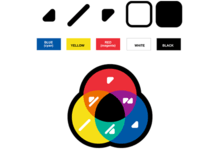Coloradd
Coloradd is a sign code for aiding color blind people to recognise colors, developed by Portuguese graphic designer and professor at the University of Minho, Miguel Neiva.[1] It consists of geometric shapes representing colors and color combinations. The app won the accessibility category of the 2013 Vodafone Foundation Mobile For Good Europe Awards.[2][3]
Code

The code is based on five base signs: two triangles (one angled upwards and the other angled downwards), one diagonal line, one solid square box and one empty square box representing black, white and the primary colors: red (magenta), blue (cyan), and yellow. Colors derived from other colors have the symbols of the combined colors, creating derivative colors (orange, green, purple and brown) and dark or white tones. Metalized colors like silver or gold are shown with a left parenthesis on the symbols.
Uses and recognitions
Since its creation, Coloradd has been applied in various services, mainly in Portugal:
- Hospitals: on patient wristbands, pill bottles and path lines[4]
- Schools: Viarco coloring pencils[5][6] and students' note books[6]
- Transports: subway maps,[7][8] traffic lights and parking lots[9]
- Accessibility: paint cans, groceries, postage services,[9] energy monitoring[10]
It was also recognised by Buenos Aires University and TEDx Oporto.
In September 2017, Mattel launched a colorblind-friendly version of Uno that utilizes ColorADD.[11]
References
- "ColorAdd®, o código de cores para daltónicos" (in Portuguese). Retrieved 14 September 2013.
- "Dyslexia and Breast Cancer Apps Amongst Winners at €200,000 Vodafone Foundation Mobile For Good Europe Awards, 06 December 2013". Archived from the original on 28 May 2014. Retrieved 27 May 2014.
- European Disability Forum. Mobile for Good Europe Awards: Application which enables colour-blind users to understand colours & information based on colours winds 30,000E award Archived 2014-05-28 at the Wayback Machine.
- Health & hospitals
- Viarco official website Archived 2013-03-12 at the Wayback Machine
- Education
- Transport
- Oporto metro
- Accessibilities
- Cloogy is the first technological equipment to integrate ColorADD February 27, 2013
- After 46 Years, Mattel Redesigned Uno For Color-Blind People September 6, 2017
Further reading
- A Practical Guide to Designing with Data by Brian Suda. 2010. Five Simple Steps., pages 61–62
- Portuguese designer becomes "hero" for the colourblind. 21 Mar 2012, Agence France-Presse
- Making More Health, Miguel Neiva
- icograda: International Council of Graphic Design Associations description and Reinventing the Color Wheel. icograda International Council of Communication Design
- Zero project, Innovative Practices 2014 on Accessibility: Colour identification system for the colourblind